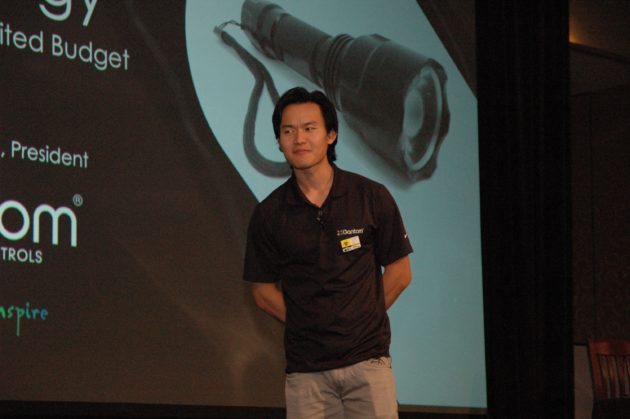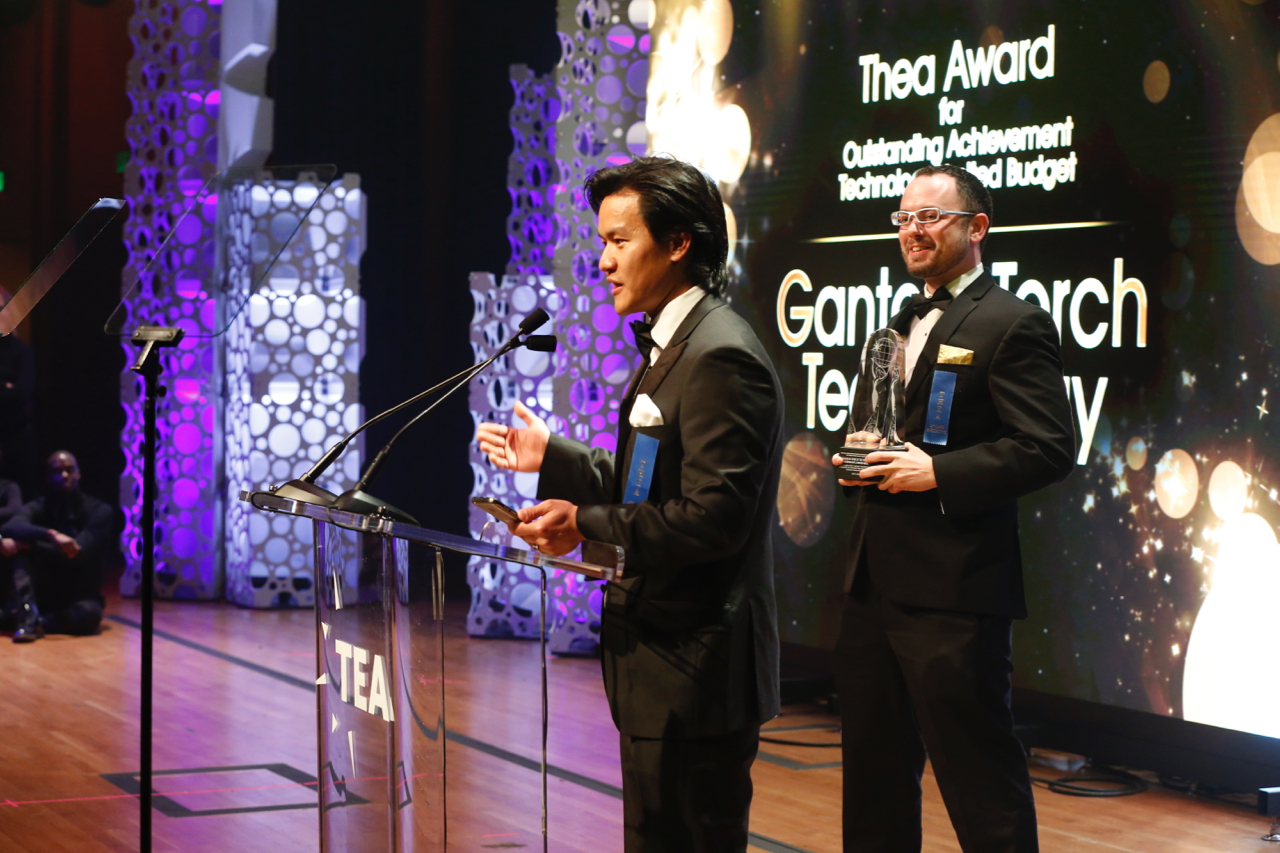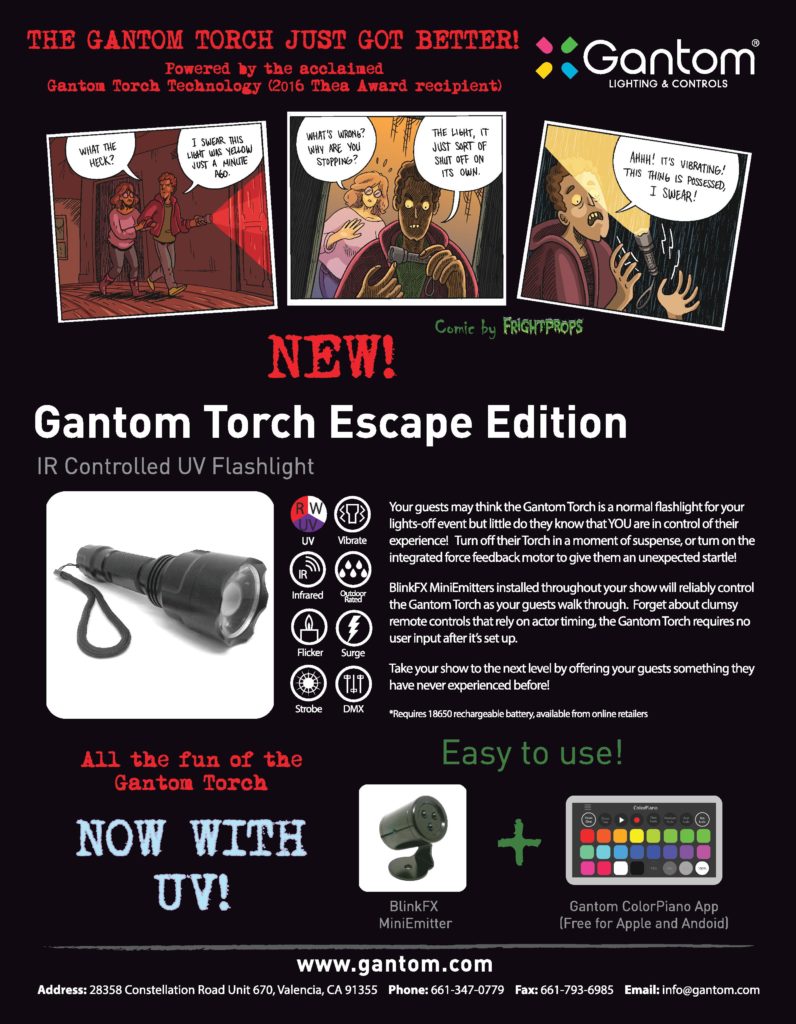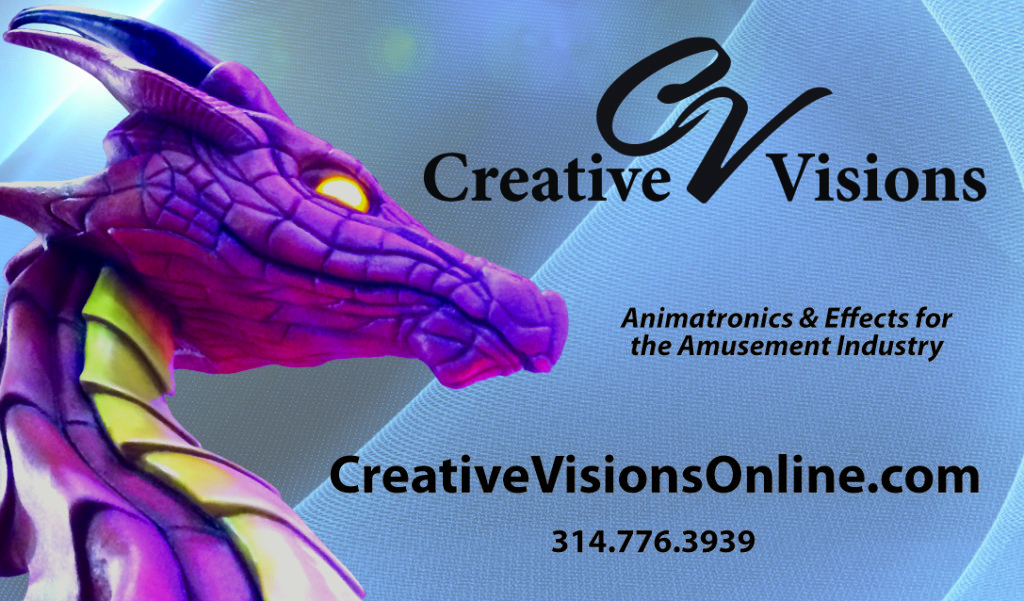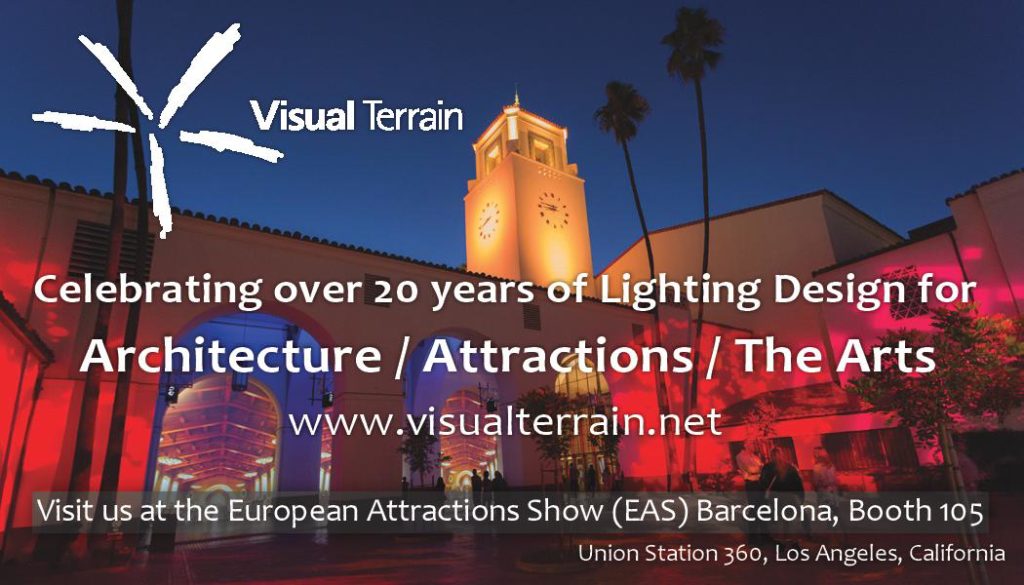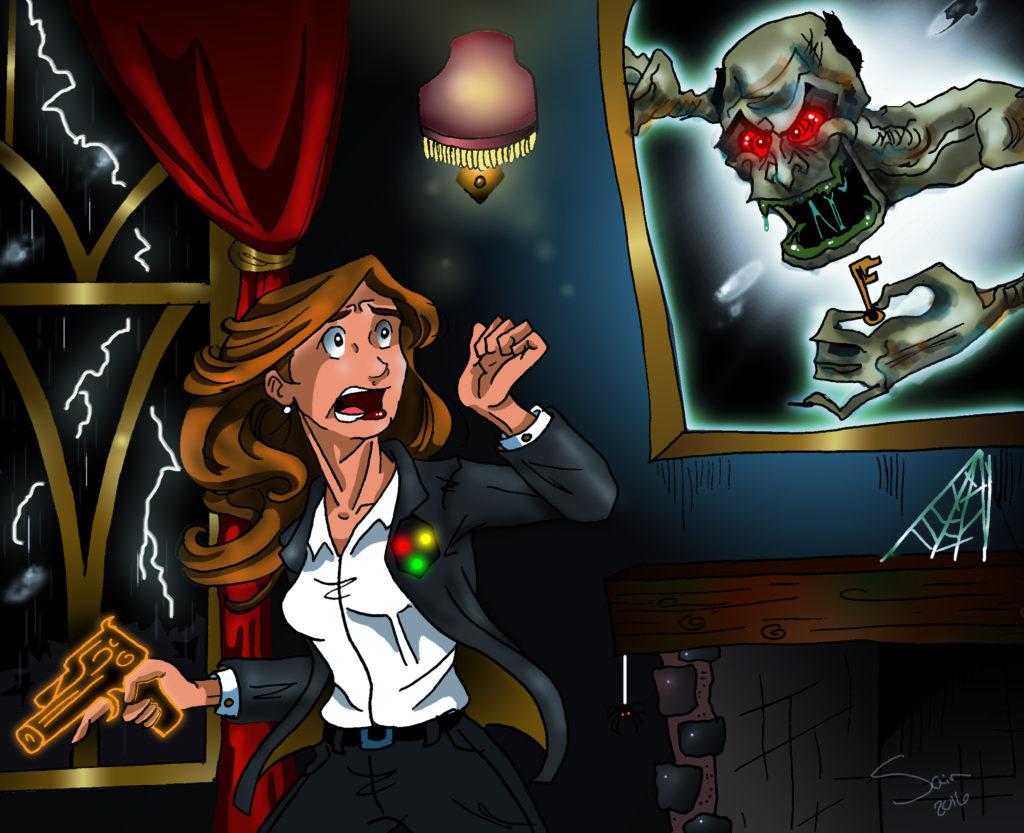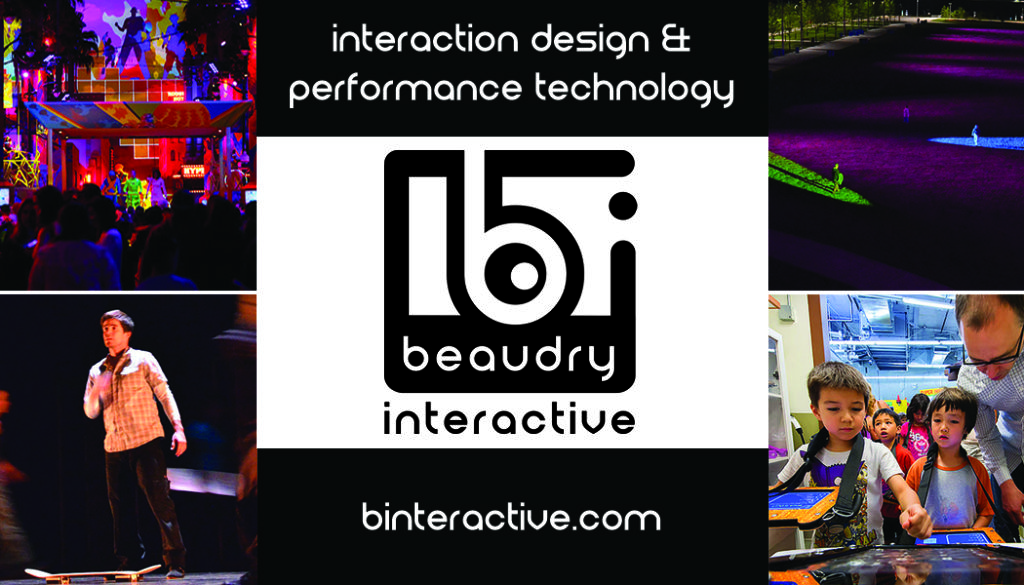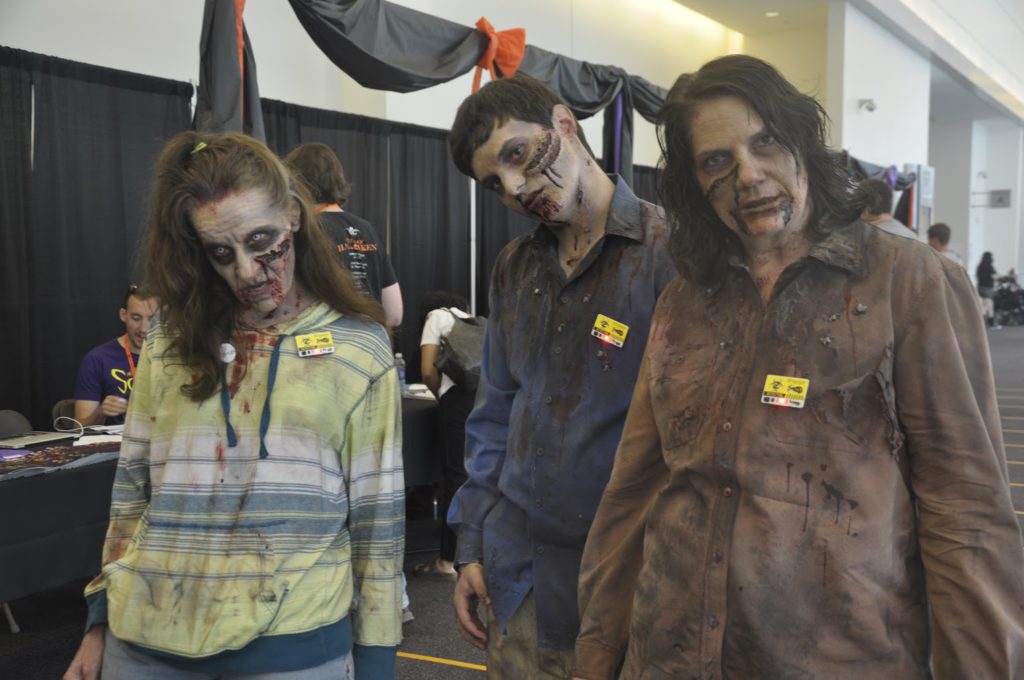Designers imagine ways to develop Gantom Torch Technology in new attractions
edited by Judith Rubin
Gantom Torch Technology, developed by Gantom Lighting & Controls, received a Thea Award this year – a prestigious honor conferred by the Themed Entertainment Association (TEA) that was in recognition of the technology’s creative potential.
The company began rolling out the Torch technology about a year ago, with demonstrations at various trade events. At its heart is simple infrared (IR) communication between beacons placed in the environment and devices worn or held by the guests.
[quote]Gantom Torch supports what we call the new interactivity – narrative environments that respond in real time to actions initiated by the guests.”[/quote]
The best known applications so far are a flashlight type device, the eponymous Gantom Torch, and ZTag, a zombie tag game in which players wear responsive badges (described in more detail in sidebar).
Gantom Torch supports what we call the new interactivity – narrative environments that respond in real time to actions initiated by the guests. Thanks to technologies that are more sophisticated and more affordable and integration-friendly than ever before, designers can create and visitor attractions can offer environments that are more immersive, more intuitive and more magical than ever before.
Torch technology has so far been demonstrated mostly in a haunt context, but its possible applications go much further. We asked several experience designers to imaginatively explore the possibilities. Here are concepts from Dan Faupel (Creative Visions), Entertainment Design Corp., Visual Terrain, Melissa Sain, Ken Saba, Beaudry Interactive and Gantom itself.
Interactive Dark Ride
Dan Faupel, VP, Creative Visions, www.CreativeVisionsOnline.com outlines a dark ride concept that includes using the Torch for tasks that are traditionally the province of theatrical lighting design, such as UV-painted scenery effects.
A Gantom Torch looks like a handheld flashlight, but is not completely controlled by the user. It receives signals from IR beacons to change colors of its light beam, turn the light on or off, and to make the Torch vibrate in the guest’s hand. I would like to see a theme park with an old dark ride update the ride and make it interactive using Torches.
As guests board the ride car, each passenger is given a Torch. As they roll forward into the dimly lit environment, they need to use their Torches to help them see the scenes they are passing through. This adds a creepy “exploring a haunted house” feel. Changing colors from scene to scene affects mood and accentuates action.
In one scene, the walls can be scenic painted to look one way under normal lighting, and another way under ultraviolet (UV) light. When people ride into the scene the Torches are emitting ordinary white light. Midway through the scene the Torches switch to UV light, darkening the scene and magically transforming the room and revealing a community of ghosts.
In another scene, the Torches start to flicker and go out. The guests spend a few moments in pitch blackness. Suddenly scenic lights pop on revealing monsters right next to the guests which shoot loud bursts of air at the guests. At the same time the Torches vibrate in the guests’ hands, all combining for a great startle scare.
Another scene has hidden speakers down both sides of the room. A mysterious voice whispers, “I can see you,” taunting the riders to shine their Torches this way, then that, revealing nothing. Finally an animatronic monster (a shark, for instance) jumps out to scare the pants off the guests.
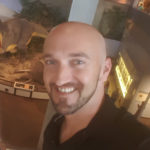 Dan Faupel ([email protected]) is VP of Creative Visions. He is the former owner of Themed Attraction Design, and former Senior Designer at Sally Corp. Creative Visions designs and builds attractions, animatronics and scenic props for theme parks, museums, zoos, haunted houses, retail stores, restaurants and FECs worldwide.
Dan Faupel ([email protected]) is VP of Creative Visions. He is the former owner of Themed Attraction Design, and former Senior Designer at Sally Corp. Creative Visions designs and builds attractions, animatronics and scenic props for theme parks, museums, zoos, haunted houses, retail stores, restaurants and FECs worldwide.
Escapology 2.0
Richard Wechsler, Entertainment Design Corp. www.entdesign.com, describes a maze environment that uses both a handheld and a worn device, plus a variety of other immersive effects.
Sharing a table at the 2016 Thea Awards in Anaheim, EDC and Gantom compared interactive notes. We told of creating the Wishing Crystal for Galaxy Macau, an interactive attraction where guest circulation around giant crystals set in a reflective pool of water triggers an ever-changing sound/light environment.
The conversation morphed into an ad-hoc blue-sky symposium (Greek word for ‘drinking party’) as we explored the possibilities of an interactive-immersive experience that fused the thrills and frissons of haunter technology with EDC’s recent foray into escape room designs.
Quan kept reminding us to just dream up a cool experience and he and his team would figure out the ‘Gantometry.’
We riffed on the concept of Ariadne’s Thread – after the legend of Ariadne giving the hero, Theseus, a ball of thread to unwind as he went deeper and deeper into a maze so that he could eventually find his way out (primitive GPS). Our maze would have four sections, representing different decades from the ‘60s to the present. There would be two teams and each team player would be armed with a ‘Gantometer’ (Torch) and a vest with embedded ‘wink buttons.’ As teams found their way through the four different segments of a mirror maze, their devices, programmed by a puzzle master would activate UV clues, augmented reality (AR) effects, and pop-up, holographic period-costumed icons that would point the right (or wrong) way and then vanish.
The colored ‘wink buttons’ would indicate which team members should work together – in essence, a mash-up of multi-narrative and interactive modalities, integrated into an escape-oriented, interactive and immersive experience. NDAs forbid me from saying more…
 Richard Wechsler ([email protected]) the Academy Award-nominated producer of the film classic, Five Easy Pieces, is EDC’s head writer and director of projects. Following a collaboration in 2000, he teamed with EDC founder Jeremy Railton to help create the live shows, events and attractions that EDC creates for audiences around the world.
Richard Wechsler ([email protected]) the Academy Award-nominated producer of the film classic, Five Easy Pieces, is EDC’s head writer and director of projects. Following a collaboration in 2000, he teamed with EDC founder Jeremy Railton to help create the live shows, events and attractions that EDC creates for audiences around the world.
Sleep no more, Hamilton
From the team at Visual Terrain, www.visualterrain.net: “While we have used previous Gantom products for architecture and attractions, we think Gantom Torch has particular applications in the arts and live productions.”
Three examples:
• Interactive theatrical productions, such as “Sleep No More” (currently showing at New York’s McKittrick Hotel). This site-specific retelling of Shakespeare’s Macbeth has the audience wandering through the halls of an old hotel, where they see scenes as they unfold. (Similar to the well-known “Tamara” production that played in Toronto, Los Angeles, New York and around the world in the 1980s and ‘90s.)Audience and actors could be given Torches, and the intensity and colors could be adjusted throughout the space and the show to support and tell the story. The audience’s lights could act as regular flashlights as they are wandering the halls, then change color as they entered a room where a scene is unfolding.
• Live stage show environment. At the 2016 Thea Awards, Visual Terrain principal lighting designer Steven Young worked with Thea Awards producer The Hettema Group and composer Andy Garfield, who conceptualized a “Hamilton” – inspired rap and dance sequence highlighting Gantom Torch Technology. The song’s verses listed off each feature, and the Torches were programmed to match, and then explode into other effects during the choruses of the song.
• Signature device and souvenir. Visual Terrain CEO and Principal-in-Charge, Lisa Passamonte Green, said, “Imagine you go to a live theme park show, and at the beginning of the show, you are handed a customized Gantom Torch, that is either themed to the show, or has the name of the show or park printed on it. You experience the production using the Torch; at the end of the show, you either return it to a bin, a la 3D glasses, or you have a cool souvenir to take home with you.”

 Founded in 1995, Visual Terrain is celebrating over 20 years of lighting design for architecture, attractions and the arts. The company’s main office is in Los Angeles, with an additional office in Chicago, as well as an international representative near Paris. Contact David Green [email protected]. Photos: Lisa Passamon Green (left) and David Green (right).
Founded in 1995, Visual Terrain is celebrating over 20 years of lighting design for architecture, attractions and the arts. The company’s main office is in Los Angeles, with an additional office in Chicago, as well as an international representative near Paris. Contact David Green [email protected]. Photos: Lisa Passamon Green (left) and David Green (right).
A dark and stormy escape room
Melissa Sain’s concept features a handheld weapon that tells you when it is out of ammunition, as well as an interactive badge.
It’s a dark and stormy night. Scattered around you is the aftermath of a homicide. The stiletto in the victim’s back is still damp with blood. The deceased is clutching an old skeleton key.
Lightning strikes and the house is suddenly dark. An evil cacklerings out. Your attention is riveted to the only light source: the grisly, frightening, spectral image of the murderer in a mirror above the dusty fireplace. His bony hand now clutches the skeleton key.
The lights flicker back on. Armed only with your detective’s badge, your wits, and a weapon, you must investigate this paranormal homicide case and retrieve the mysterious key, all while trying to catch a killer and not end up the next victim.
In this escape room, you can touch the props, explore the scenery, and live in the environment – and all the elements are active participants. Sensors in your detective badge register when you near a certain prop or area that propel the story/investigation further. For instance, a book on a shelf lights up when you approach it. When you pull the book forward, it activates the secret passage in the fireplace and now you can go through and experience the next room.
Your weapon simulates a laser gun. It also lights up to notify you when you are low on ammo – or out completely. Now, not only are you trying to outsmart a phantom murderer, you must juggle the challenge of finding ammo. The weapon will vibrate when you near a spot where you can “reload” and then continue on with the investigation.
What if the lamp were to get brighter when nearing a clue and dim when you’ve traveled too far? It enhances that moment of problem solving and helps guide you to the next step.
 Melissa Sain ([email protected]) is a recent graduate of the Art Institutes with her Bachelor’s in Graphic and Web Design. As a freelance novelist and illustrator with a touch of theatre experience, she has begun the arduous task of creating her graphic novel. Her love of all things Halloween, paranormal, and murder investigating help to fuel her creativity for being sophisticated and creepy.
Melissa Sain ([email protected]) is a recent graduate of the Art Institutes with her Bachelor’s in Graphic and Web Design. As a freelance novelist and illustrator with a touch of theatre experience, she has begun the arduous task of creating her graphic novel. Her love of all things Halloween, paranormal, and murder investigating help to fuel her creativity for being sophisticated and creepy.
Sherlock – an elementary deduction
Ken Saba, www.kensaba.com conceives an experience around a popular IP and adds new dimensions of interactivity with an app and a rich web of communications.
Welcome to modern day London and 221B Baker Street – home of Sherlock Holmes and Dr. John Watson. Created and produced by Steven Moffat and Mark Gatiss, Sherlock (2010 – present) is a crime-drama movie series based on Sir Arthur Conan Doyle’s Sherlock Holmes detective series. It is reimagined in the present day; Sherlock (Benedict Cumberbatch) and Dr. Watson (Martin Freeman) are “consulting detectives” for Metropolitan Police Service Detective Inspector Greg Lestrade and others as they solve a variety of crimes and counter Holmes’ arch-nemesis: Jim Moriarty.
Recruited as “Special Constables” for the Metropolitan Police, guests journey through the world of Sherlock. Their “Special Constable’s” torches trigger sensors of various interactive elements within the stories and scenes. Whether photographs, portraits, or radio and television broadcasts that come to life with immersive media or theatrical tricks of animated props or theater devices – pointing the Torch in the right direction enables these clues to magically present themselves as a step closer to the elementary solution.
The Torch is also a lighting device that visually helps the drama and mystery unfold – and it also prompts the Sherlock app. Via the Sherlock app on their mobile devices, guests receive clues and texts from Sherlock and Dr. Watson – and can send them as well. However, Moriarty is not far behind with his taunting messages of chilling insanity. You can never be certain who is receiving your texts.
From 221B Baker Street – the “Special Constables” adventure takes them to the crime lab of the Metropolitan Police, Baskerville testing site, and other, well-known settings within Sherlock’s world and episodes from the television series. Guests experience Sherlock’s art of deduction through his solving of the crimes with Dr. Watson but also by entering Sherlock’s “Mind Palace.”
 Ken Saba is a media producer and editor for the themed entertainment industry, most recently with Walt Disney Imagineering where he worked on media for several new and updated attractions and preshows that recently premiered in Disney parks. His experience also includes editing and visual effects design for Louisiana’s Old State Capitol: The Ghost of the Castle (for BRC Imagination Arts), Director of Photography and Editor for NASA, and numerous broadcast credits.
Ken Saba is a media producer and editor for the themed entertainment industry, most recently with Walt Disney Imagineering where he worked on media for several new and updated attractions and preshows that recently premiered in Disney parks. His experience also includes editing and visual effects design for Louisiana’s Old State Capitol: The Ghost of the Castle (for BRC Imagination Arts), Director of Photography and Editor for NASA, and numerous broadcast credits.
An expressive luminaire
Ryan Dorn, director of production, Beaudry Interactive (binteractive.com) takes Gantom Torch technology into operations as well as guest experience.
The Gantom Torch is effectively a mobile lighting fixture with real-time wireless control. As such it’s possible to utilize this technology to create show elements anywhere by placing them in the hands of cast, crew and even guests.
Staff members equipped with Torches lining a nighttime parade are able to step into the show on a given cue and provide a choreographed light show without any prior rehearsal. Guests are equally able to join in the fun without any prior instruction and participate in a group experience simply by holding a Torch and becoming a part of the moment.
Operations is another place that the Gantom Torch can provide an easy assist. Ushers using Torches are able to fall under control of the lighting board at any moment. Want all lights on or off? Hit a cue. Wish your ushers were in red light mode to not interrupt a key show moment? Hit a cue. Crowd control can even take on new methods by integrating color coded lights that change as your Stage Manager calls from behind the scenes. Hold back a crowd from crossing a parade route by turning your staff lights red. When the moment is clear to cross, the SM calls a clear and the lights change to green. Both staff and guests are instantly cued and all by a simple localized lighting shift delivered via IR blasters. The same level of control could be exerted in ride cues, maze experiences or simply directing traffic outside the venue.
Whether it’s a quick interactive moment where your guests take part of a choreographed light show or you want operational control over your staff’s hand-held luminaire, the Gantom Torch is a versatile tool to have in the bag.
 Ryan Dorn ([email protected]) has always been at home abusing technology for the sake of art. He has worked in formats ranging from live theater to themed entertainment to industrial showcasing and experiential design to episodic television. He has primarily worked with digital media and its various work flows and spent the most recent part of his career focusing on practical applications of physical interaction design.
Ryan Dorn ([email protected]) has always been at home abusing technology for the sake of art. He has worked in formats ranging from live theater to themed entertainment to industrial showcasing and experiential design to episodic television. He has primarily worked with digital media and its various work flows and spent the most recent part of his career focusing on practical applications of physical interaction design.
ZTag zombie infection
Gantom has just launched a new business venture around ZTag, an interactive, zombie-themed role playing game that uses the Gantom Torch Technology. We interviewed Quan Gan while he was in Shanghai running a promotional ZTag event.
How does ZTag utilize Gantom Torch Technology?
ZTag uses bi-directional IR communication. Each ZTag badge worn by a player can receive a signal, act upon it, and send its own signal.
Tell us about the game.
Humans get hunted by zombies but have the ability to fight back by completing a mission to visit all the checkpoints (collecting ingredients to the antidote). Should they succeed, they become immune and can disable zombies. if a zombie catches a human, the human will turn into a zombie and must further infect other humans.
People are sprinting most of the time to either hunt or escape, and there are elements that encourage teamwork. Eight-minute rounds seem to be ideal, within which humans need to find six checkpoints on the field. We start with only a few zombies, watch the infection spread and see players develop strategies.
Costume elements and props add hilarity.
ZTag shares similaries with Pokemon GO in several ways: it’s getting people outdoors and exercising! It’s bringing back some old familiar concepts and adding a new twist. And it’s highly addictive. Where I think ZTag stands out is that it’s a much more active game – people aren’t looking down at a screen and walking but rather dashing to the next checkpoint while dodging zombies. By its nature, ZTag, encourages more social interaction.
What made you decide to base a new business on ZTag?
We just see so many options that we know it’s worth the investment.
• Bi-directional communication opens up a wide range of possibilities simply through player behavior. Since the players are sending signals and acting as stimulants to the system, very complex results can emerge.
• We see a huge trend blending the lines between offline and online experiences – entertainment venues are constantly adding new “connected” tech to interact with their audience while online games are finding their way into the physical space (Pokémon GO is an example).
ZTag sits right in between: people are chasing people in real life and then telling their friends on social media how well they did. We’re bringing schoolyard tag back with a tech twist.
What are some of the possible ways to customize?
There are many variations from simple parameter changes (already supported in the game) to complete game architecture rewrite for a specific application.
• Tourist destination: Players go on a scavenger hunt that takes them to local businesses and landmarks.
• Obstacle course with physical challenges and puzzles to solve.
• Trade shows: Drive traffic to sponsor booths.
• Haunted attraction
• Race: Zombies chase you. If you get infected, you have a certain amount of time to try and reach the mile marker before turning into a zombie.
• There are more complex possibilities where the platform can be reworked for speed dating or interviews, or even to use as a research tool to study certain kinds of behavior. ZTag is a simple wearable computer with input and ouput – what you want to do with it is entirely up to the software.
What does an operator need in terms of a venue or setting, and the investment?
We need running space that’s at least the size of a basketball court. Having some varied terrain or obstacles can add to the excitement. We are getting lots of interest from paintball and laser tag operators. ZTag is similar to lasertag but without guns – which can potentially capture more female players. Many paintball fields don’t operate at night, which is actually when ZTag works really well (lights are more visible) and goes with the zombie theme… so this would be an easy addition to their existing business model.
Investment is minimal because the ZTags are designed to be high volume consumer products on a range of a few dollars. Generally a few thousand dollars is what is takes to get started hosting a ZTag game. • • •


